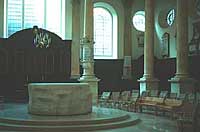
How Do Visual Arts Shape Spiritual Life?
Building Anglican Liturgy

Photo courtesy of the author
St. Stephen Walbrook
![]()
Building Anglican Liturgy
Response: Giving
Form to Anglican Liturgy in the City Churches of London
John W. Dixon, Jr.
A basilican plan, the altar at the far end of a rectangular space (which is used in several of the City churches), emphasizes the processional way, the sacred journey, the sense of a passage through time. The central plan with the altar in the center of a square or circular building emphasizes the gathered community, here, in the present, suspended out of time. An emphasis on the vertical is an important element in sacred symbolism (which it will probably continue to be for many people, even though, with space travel, we know better). An emphasis on the horizontal is the humanistic dimension of the experience of the sacred. None of these plans is the "right one"; they are symbolic forms of equal validity. I have no quarrel with any solution, so long as the people involved know what they are doing.
Wren's solution works for the Anglican liturgy. The altars are at one end or against one wall, retaining a sense of the sacred way from the entrance to the altar and clarifying the different functions of the clergy and the laity. At the same time he has pulled the pews forward so that all the people are gathered near the altar. There is a harmonious balance between vertical and horizontal. His various solutions are splendid realizations of an essentially Anglican sense of the liturgy. These are not forms to be imitated but models of thought. His vocabulary is not ours but the integrity of his thinking could be.
St. Stephen Walbrook in particular is extolled by architectural historians who are indifferent to its proper function in the liturgy. Since St. Stephen is so subtle a spatial ordering, I would much like to know how its original parishioners, not trained in the apprehension of architectural spaces, felt about it. There is a clue in the modern parish. A monumental stone altar carved by Henry Moore has been placed in the center under the dome and rather elegant blond wooden chairs surround the altar. Because of this, the combination of symbolic movements made possible in the original church are blocked off and the old altar looks rather disconsolate off to the side and ignored. It is easy to see the intent of the parish; they wanted to shift the emphasis more to the gathered community, the family gathered around the family table. But it isn't a table.
A Christian altar is two or three things. On the one hand, it inherits all the ancient symbolism of a massive stone block for the offering of sacrifice. At the same time, given the presence of the relic of a martyr in or under the altar, it is a sarcophagus and a tomb. In this case there is no relic and the thing itself is a heavy, massive circular stone block, subtly carved. It would seem to be a deliberate denial of the principle of the table. The cause is a worthy one, to redefine the church building in terms of changed understanding of this church but it all seems to deny what Wren achieved.
